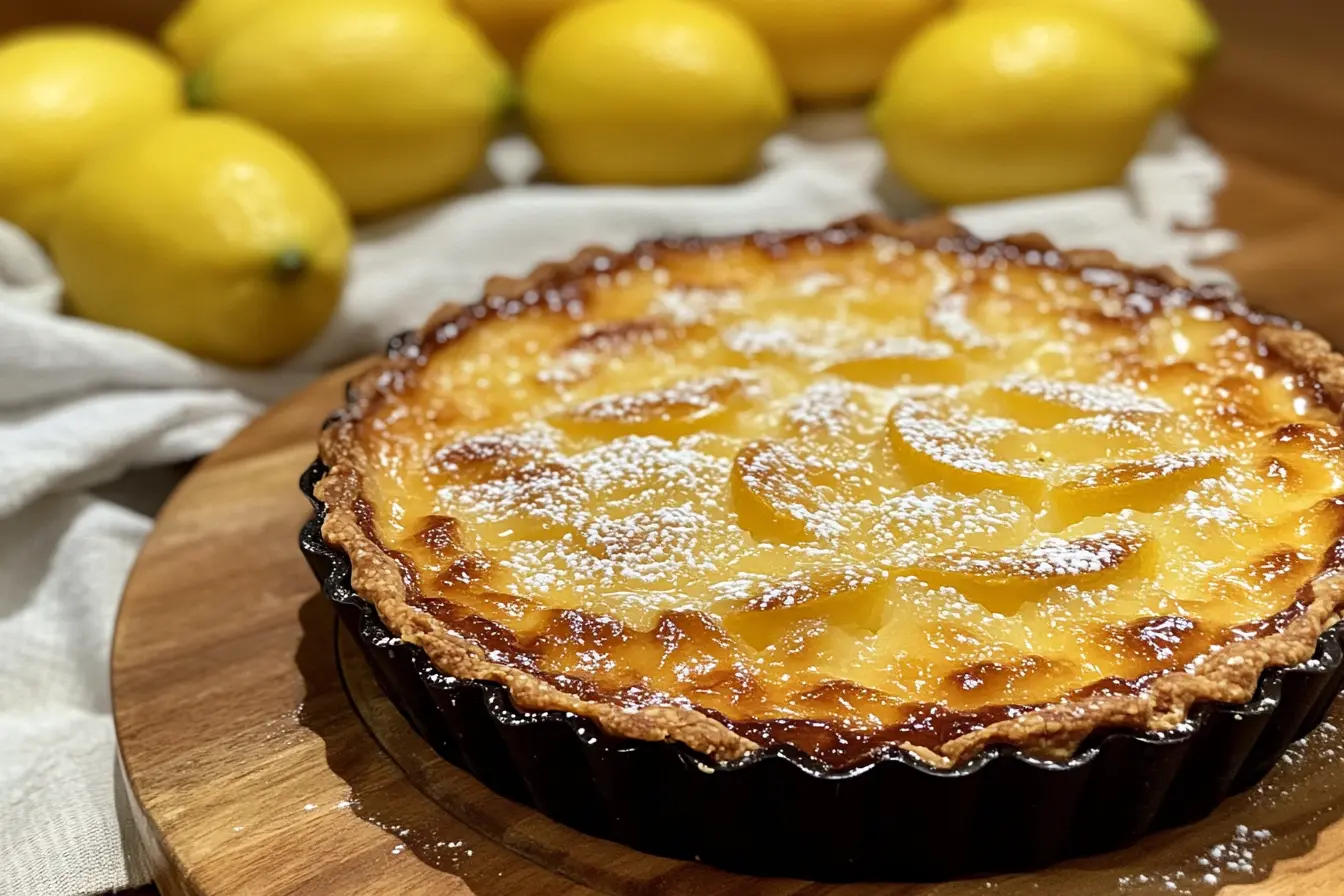Can I Use Lemon Pie Filling Instead of Lemon Curd? Discovering alternatives in baking can be both a lifesaver and a fun experiment. This article explores whether you can substitute lemon pie filling for lemon curd. We’ll discuss the differences between these two citrusy delights, when substitutions work (or don’t), and how to adapt recipes for the best results. With expert tips and guidance, you’ll soon master your lemony creations!
Introduction
Is It Possible to Substitute Lemon Pie Filling for Lemon Curd?
Baking is as much about creativity as it is precision. Although lemon curd and lemon pie filling both give sweets a citrus boost, their flavors, textures, and uses are very different. Whether you’re out of one or curious about their interchangeability, this guide dives deep into the nuances of both, helping you decide when and how to substitute them.
For instance, lemon curd is rich and creamy, often used as a topping or filling, while pie filling is sweeter, gelatinous, and designed specifically for pies. So, what happens when you swap one for the other? Let’s uncover the details.
Understanding Lemon Pie Filling and Lemon Curd
What Is Lemon Pie Filling?
Lemon pie filling is a pre-made or homemade mixture specifically crafted for pies. It has a smooth, thick, and slightly gelatinous consistency, designed to hold its shape within a crust. Typically, the filling is made from ingredients like water, sugar, cornstarch, lemon juice, and sometimes egg yolks or food coloring for a vibrant yellow hue.
This filling offers a sweet yet tangy flavor, but its sweetness often dominates, making it a perfect complement to buttery or flaky pie crusts. Commercial versions are widely available, offering convenience for bakers. However, they may lack the depth of flavor found in fresh, homemade alternatives.
What Is Lemon Curd?
In contrast, lemon curd is a luxurious, velvety spread made by carefully cooking eggs, butter, sugar, and fresh lemon juice. Its rich, creamy texture sets it apart from pie filling, providing a more intense lemon flavor with a balance of tartness and sweetness.
Traditionally, lemon curd is used as a topping for scones, a filling for tarts, or even a spread for cakes. Because it is more versatile than pie filling, it works well in recipes where bold lemon flavor and creamy consistency are desired.
Key Differences Between Lemon Pie Filling and Lemon Curd
Though both bring the essence of lemon to your dishes, their differences are striking:
| Aspect | Lemon Pie Filling | Lemon Curd |
|---|---|---|
| Consistency | Gelatinous, holds shape in pies | Creamy, soft, spreadable |
| Flavor | Sweeter, less tart | Boldly tart, well-balanced |
| Ingredients | Cornstarch, water, sugar, lemon juice | Eggs, butter, sugar, fresh lemon |
| Uses | Primarily for pies | Tarts, spreads, toppings |
These differences make it essential to consider the context of your recipe before deciding on a substitution.
Pro Tip:
If you’re aiming for the intense citrus kick that only lemon curd provides, you might need to adjust the lemon pie filling with fresh lemon juice or zest to enhance its flavor.
Substituting Lemon Pie Filling for Lemon Curd
When Can You Use Lemon Pie Filling Instead of Lemon Curd?
It can be a viable substitute for lemon curd in certain recipes, particularly those where texture and consistency aren’t the star players. For example, in desserts like layered trifles, parfaits, or as a filling for basic cakes, pie filling works quite well because it retains its form and integrates smoothly.
Additionally, pie fillings can be a lifesaver when you’re short on time. Since they’re often pre-made, they offer the convenience of skipping the stovetop process required for lemon curd. This makes them suitable for last-minute bakes or when precision isn’t crucial.
Recipes where substitution works best include:
- Lemon meringue pies
- Cake layers requiring a citrusy center
- No-bake cheesecakes
- Dessert bars or squares
Recipes Where Substitution May Not Work
However, there are instances where the differences between lemon pie filling and lemon curd are too significant to ignore. Recipes demanding the rich creaminess or intense tartness of curd won’t benefit from pie filling substitutions.
Avoid substituting in:
- Tartlets or mini pastries where curd acts as the primary filling.
- Desserts relying heavily on the tangy flavor to balance sweetness, such as lemon pavlova.
- Recipes requiring a spreadable or highly emulsified consistency.
When the recipe centers on the taste and mouthfeel of lemon curd, using pie filling can result in an overly sweet or underwhelming dish.

Tips for Adjusting Recipes When Substituting
To bring lemon pie filling closer to the flavor and texture of lemon curd, you can make a few tweaks. These adjustments help mimic the creaminess and vibrant tanginess characteristic of curd:
- Add Fresh Lemon Juice or Zest: Incorporating fresh lemon juice enhances tartness, while zest deepens the citrus flavor.
- Blend in Butter: Whisking a small amount of melted butter into the pie filling can create a silkier, richer texture, similar to curd.
- Use Egg Yolks (Optional): If the recipe allows, slowly cook the filling with egg yolks to mimic curd’s consistency.
- Reduce Sweetness: Balance the sweetness of the pie filling by pairing it with less sugary elements, like plain shortbread crusts or whipped cream.
Culinary Applications
Common Recipes for Lemon Pie Filling
Lemon pie filling is a versatile ingredient, often found in traditional baked goods where its thick, gelatinous texture provides structure. Here are some popular recipes that showcase its strengths:
- Classic Lemon Meringue Pie: A quintessential dessert, lemon pie filling serves as the star under a fluffy layer of toasted meringue.
- No-Bake Lemon Bars: Combining crushed biscuits and a pie filling layer, these bars are perfect for quick and delightful treats.
- Layered Parfaits: Alternating layers of lemon pie filling, whipped cream, and crushed cookies create a visually stunning and delicious dessert.
- Lemon Poke Cake: This involves drizzling the filling into holes poked into a baked cake, infusing it with citrusy goodness.
These recipes are straightforward and emphasize the sweet, mild tang of the filling.
Common Recipes for Lemon Curd
Lemon curd excels in recipes that demand richness and bold flavor. Its creamy, velvety texture makes it the ideal choice for:
- Tarts and Tartlets: Lemon curd shines as the main filling in buttery tart shells, delivering an elegant dessert.
- Layered Cakes: Its intense flavor pairs beautifully with vanilla or almond cakes, acting as both a filling and frosting alternative.
- Pavlova Topping: A dollop of curd atop a pavlova adds depth and a sharp tang to balance the dessert’s sweetness.
- Scones and Biscuits: Spread curd over warm scones for an indulgent tea-time treat.
These recipes highlight curd’s luxurious qualities and its ability to transform simple baked goods into sophisticated desserts.
Versatility in Baking and Desserts
The beauty of both lemon pie filling and lemon curd lies in their adaptability. While they have distinct characteristics, their overlap in certain applications allows for culinary creativity. For example:
- Cheesecake Toppings: Both can work as toppings, depending on whether you prefer a creamy or firm layer.
- Swirl Effects in Baked Goods: Their vibrant color and bold flavors make them ideal for swirling into cakes or muffins.
- Dessert Layers: Layered trifles or parfaits are fantastic platforms for experimenting with both fillings.
By understanding their strengths, you can tailor each ingredient to elevate your dessert game.

Nutritional and Storage Considerations
Nutritional Comparison
When deciding between lemon pie filling and lemon curd, it’s worth considering their nutritional profiles. While both are indulgent, their calorie, sugar, and fat content vary significantly due to differences in ingredients.
Here’s a breakdown of their average nutritional content (per 100g):
| Nutrient | Lemon Pie Filling | Lemon Curd |
|---|---|---|
| Calories | 200 kcal | 250 kcal |
| Fat | 0.5 g | 10 g |
| Carbohydrates | 45 g | 35 g |
| Sugar | 40 g | 30 g |
| Protein | 0.5 g | 2 g |
Key Takeaways:
- Lemon pie filling is lower in fat, making it lighter but significantly higher in sugar.
- Lemon curd has a richer flavor and texture due to the presence of butter and eggs, contributing to higher fat content.
For health-conscious bakers, adjustments like reducing sugar in recipes or using smaller portions can help manage caloric intake.
How to Store Lemon Pie Filling and Lemon Curd
Proper storage is crucial to maintaining the flavor and freshness of both lemon pie filling and lemon curd. Here’s a quick guide:
Storing Lemon Pie Filling:
- Homemade: Store in an airtight container in the refrigerator for up to 3 days.
- Canned (Unopened): Shelf-stable for up to a year when kept in a cool, dry place.
- Opened: Refrigerate immediately and use within 1 week.
Storing Lemon Curd:
- Homemade: Due to its high butter and egg content, lemon curd requires refrigeration. Store in a sealed jar and consume within 1-2 weeks.
- Commercial: Check the packaging for shelf life but refrigerate after opening.
Freezing Tips:
Both can be frozen for extended storage:
- Transfer into freezer-safe containers, leaving some space for expansion.
- Freeze for up to 3 months. Thaw in the refrigerator overnight before use.
Frequently Asked Questions
Is Lemon Pie Filling the Same as Lemon Curd?
No, they are not the same. Lemon pie filling is typically sweeter and gelatinous, designed for structural purposes in pies. In contrast, lemon curd is creamier, richer, and more tart, often used as a topping, spread, or standalone dessert.
Can I Make Lemon Curd From Lemon Pie Filling?
While it’s not a direct substitute, you can enhance lemon pie filling to mimic lemon curd. Try adding melted butter, fresh lemon juice, and egg yolks, then cook gently until the mixture thickens to achieve a creamier, richer result.
Which Is Healthier: Lemon Pie Filling or Lemon Curd?
It depends on your dietary goals. Lemon pie filling is lower in fat but higher in sugar, while lemon curd contains more fat due to butter and eggs but is slightly less sugary. For a balanced choice, opt for smaller portions of either.
Can Lemon Pie Filling Be Used for Tarts?
Yes, lemon pie filling can be used for tarts, especially in recipes requiring a firmer, more structured filling. However, the flavor might not be as bold or tangy as that of lemon curd, which is often preferred for tarts.
How Can I Enhance the Flavor of Lemon Pie Filling?
To elevate the flavor, mix in fresh lemon juice or zest for a sharper citrus taste. Adding a small amount of butter can also enrich the texture, while a pinch of salt can balance sweetness.
Is Homemade Lemon Curd Better Than Store-Bought?
Yes, homemade lemon curd usually has a fresher, more vibrant flavor because it uses fresh lemons, real butter, and eggs. Store-bought versions can be convenient but may contain preservatives and artificial flavoring, which alter the taste.
Conclusion
Summing Up the Substitution
The choice between lemon pie filling and lemon curd ultimately comes down to the recipe and the flavor you want to achieve. While lemon pie filling can be a handy substitute in specific dishes like pies and layered desserts, it lacks the intense tartness and creamy texture that make lemon curd so unique.
When substitution is necessary, slight adjustments—like adding fresh lemon juice or melted butter—can bridge the gap between the two. However, in recipes where bold flavor and richness are essential, sticking with lemon curd is your best bet.
Understanding the differences between these two delicious lemon-based ingredients can empower you to get creative in the kitchen. Whether you’re crafting a classic meringue pie or experimenting with a new dessert, knowing when and how to use each ensures your bakes will be nothing short of delightful. Happy baking!


1 thought on “Can You Substitute Lemon Pie Filling for Lemon Curd? Expert Tips!”